Upgrading your amplifier is arguably the most impactful change you can make to your electric guitar setup. Even the finest guitars, pedals, and playing techniques can fall flat without a quality amplifier to bring them to life. Finding a Good Amplifier For Electric Guitar is essential for achieving the tone you desire, whether you’re practicing at home, recording in the studio, or performing on stage.
The world of guitar amplifiers is constantly evolving, particularly with the advancements in modeling technology. We are currently in an exciting era where modeling amps are rapidly gaining popularity, offering incredible versatility and sound quality, while traditional tube amps remain cherished for their unique warmth and responsiveness. While tube amps will likely always hold a special place in the hearts of many guitarists, modern modeling amplifiers provide a compelling alternative, often delivering comparable sound quality alongside enhanced features and convenience. In fact, the very existence of these impressive modeling amps is a testament to the enduring appeal of classic tube amplifier tones they emulate so effectively.
In 2025, the market offers an extensive range of guitar amplifiers, and navigating this selection can be overwhelming. To simplify your search for a good amplifier for electric guitar, we’ve compiled a guide to some of the best options available. Our selections have undergone rigorous testing in various settings, from home practice to rehearsal spaces and live stages. We’ve evaluated their performance with different types of pickups – single coils, humbuckers, and P90s – and across a range of effects pedals to ensure they meet the demands of diverse playing styles and musical genres.
Purchasing a guitar amplifier is a significant investment, and it’s a decision that shouldn’t be taken lightly. To assist you in making the right choice, this comprehensive guide includes detailed reviews, a helpful FAQ section, and a specification comparison table. So, without further delay, let’s explore the top guitar amplifiers that you can buy right now to elevate your electric guitar playing experience.
Our Top Picks
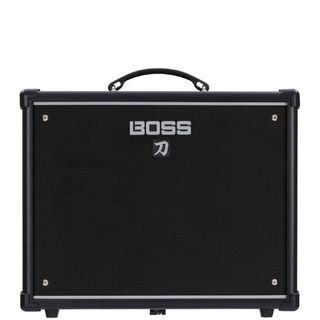 Best guitar amps: Boss Katana-50 MkII
Best guitar amps: Boss Katana-50 MkII
Best Budget
- Boss Katana-50 Gen 3
An updated version of a best-selling modeling amp, the Boss Katana-50 Gen 3 offers a brand-new amp model and studio-grade effects, providing exceptional versatility at an accessible price point.
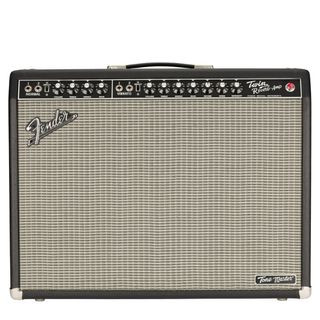 Best guitar amps: Fender Tone Master Twin Reverb
Best guitar amps: Fender Tone Master Twin Reverb
Best for Home
- Fender Tone Master Twin
A popular choice in recent years, the Fender Tone Master Twin Reverb delivers authentic tube amp tone at volume levels suitable for home practice without disturbing neighbors.
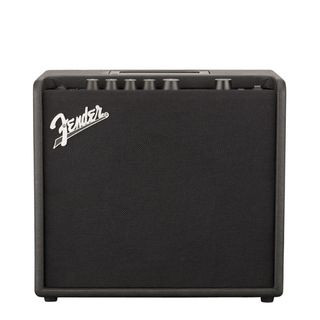 Best guitar amps: Fender Mustang LT25
Best guitar amps: Fender Mustang LT25
Best Beginner
- Fender Mustang LT25
The Fender Mustang LT25 is compact, sounds great, and is packed with amp and effect models, making it an excellent and affordable amplifier for beginner guitarists.
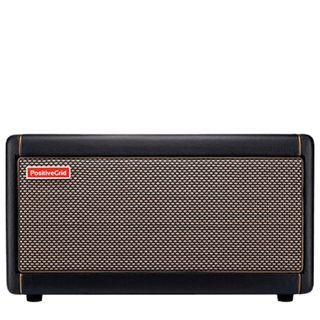 Best guitar amps: Positive Grid Spark 40
Best guitar amps: Positive Grid Spark 40
Best Practice
- Positive Grid Spark 40
For beginners or home practice, the Spark 40 offers a vast collection of sounds, featuring nearly every amp model imaginable and a wealth of high-quality effects.
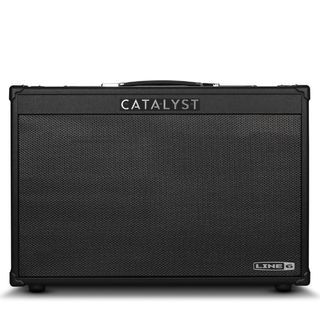 Best guitar amps: Line 6 Catalyst 200
Best guitar amps: Line 6 Catalyst 200
Best Sub-$500
- Line 6 Catalyst 200
The Line 6 Catalyst 200 is an unbeatable all-around amplifier under $500, offering gig-ready power, exceptional amp tones, and versatile effects, representing incredible value.
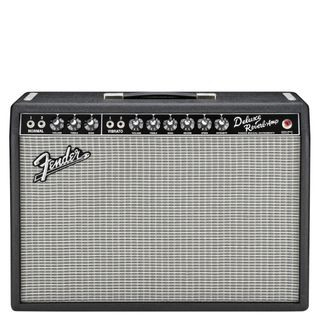 Best guitar amps: Fender
Best guitar amps: Fender
Best Tube Amp
- Fender ’65 Deluxe Reverb
The Fender ’65 Deluxe Reverb is the ultimate pedal platform amplifier, renowned for its pristine clean tone and ample headroom, making it perfect for use with stompboxes.
Best on a budget
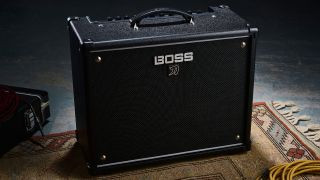 Boss Katana 50 Gen 3 guitar amplifier on a floor rug.
Boss Katana 50 Gen 3 guitar amplifier on a floor rug.
(Image credit: Boss)
1. Boss Katana 50 Gen 3
Could be all you ever need in a guitar amplifier.
Our expert review:
Specifications
Watts: 50
Type: Solid-state with digital effects
Preamp tubes: N/A
Power amp tubes: N/A
Speakers: 1×12″
Reasons to buy
- Huge range of sounds
- Great value for money
- Lots of high-quality effects
Reasons to avoid
- Needs software for deep editing
- Bluetooth is an optional extra
At a Glance
✅ Buy if you’re on a budget: The Katana offers excellent value, packed with brilliant amp and effects models, making it one of the most popular good amplifiers for electric guitar worldwide for good reason.
❌ Avoid if you don’t like using software: To maximize its potential, you’ll want to use the Boss Tone Studio software, so it’s not ideal if you prefer to avoid deep tone editing on a computer.
For any guitarist seeking an amplifier that facilitates sonic exploration, the Boss Katana 50 Gen 3 is an outstanding choice, providing a wealth of tones to experiment with. More than just a fantastic budget-friendly option, its integrated effects and connectivity make it a serious contender even for experienced players. If you’re looking for a good amplifier for electric guitar that provides exceptional value and versatility, the Katana 50 Gen 3 is hard to beat.
This latest iteration of the Boss Katana maintains its position as an ideal ‘first’ or backup amplifier for many. With the addition of a new amp model alongside the familiar suite of Boss effects, it easily bridges the gap between home practice and performing in smaller venues. Its versatility extends beyond just sound; it’s a truly good amplifier for electric guitar across various scenarios.
Connecting the Katana modeling amp to a computer unlocks extensive editing capabilities, allowing for detailed parameter adjustments. We particularly appreciated its direct recording capability via USB into a digital audio workstation. The two channels enable instant recall of your preferred tones, while comprehensive connectivity ensures seamless integration into your existing guitar rig.
Read our full Boss Katana 50 Gen 3 review
Best for home use
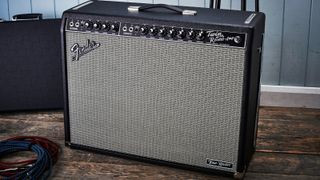 Fender Tone Master Twin Reverb guitar amplifier in a room setting.
Fender Tone Master Twin Reverb guitar amplifier in a room setting.
(Image credit: Future)
2. Fender Tone Master Twin Reverb
The original tone monster gets a modern makeover.
Our expert review:
Specifications
Watts: 200W
Type: Digital
Preamp tubes: N/A
Power amp tubes: N/A
Speakers: 2×12” Jensen N-12K
Reasons to buy
- Loads of headroom
- Incredibly lightweight
- Realistic tube tone
Reasons to avoid
- Not a proper tube amp
At a Glance
✅ Buy if you want tube tone at home: The Tone Master Twin sounds incredibly similar to its tube-powered counterpart, but at manageable volumes, making it a good amplifier for electric guitar at home, delivering great tube-like tone without excessive loudness.
❌ Avoid if you’re short on space: While lighter than the original, it’s still a 2×12 amp and requires significant space.
Many guitarists have dreamed of owning a Twin Reverb, but its weight and the need to play it at high volumes often make it impractical. The Fender Tone Master Twin Reverb addresses these issues, providing the coveted tube amp character without the physical burden or ear-splitting volume. For those seeking a good amplifier for electric guitar that captures the essence of a classic at home-friendly levels, this is a top contender.
In the lower half of its volume range, it faithfully reproduces the expansive, slightly scooped clean tone that is so highly prized in the original Twin. As you increase the volume past the halfway point, the desirable chime of overdrive begins to emerge. However, unlike a tube-driven Twin, this model can be turned up to its maximum setting, especially when using the volume attenuation switch, making it a surprisingly versatile good amplifier for electric guitar across different volume needs.
Despite being a modeling amplifier, it offers minimal editing options and lacks a companion app, focusing instead on replicating the core tone of the original. It includes a cabinet simulation feature, providing the sound of either a Shure SM57 or a ribbon microphone on the cabinet, a feature that will be appreciated by sound engineers and home recording enthusiasts alike. It’s a remarkable piece of digital technology, and while the tone might not be exactly identical to a vintage Twin, it comes incredibly close, making it a very good amplifier for electric guitar seeking that iconic sound in a modern package.
Read our full Fender Tone Master Twin Reverb review
Best for beginners
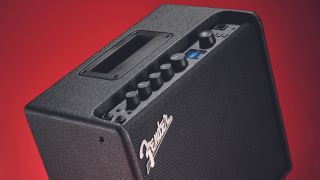 Fender Mustang LT25 guitar amplifier on a white background.
Fender Mustang LT25 guitar amplifier on a white background.
(Image credit: Fender)
3. Fender Mustang LT25
An excellent value amplifier that’s perfect for beginners.
Our expert review:
Specifications
Watts: 25W
Type: Modeling
Preamp tubes: N/A
Power amp tubes: N/A
Speakers: 1×8-inch Fender Special Design
Reasons to buy
- Super easy to use
- Lots of different tones
- Nice and compact
Reasons to avoid
- Others have more features
At a Glance
✅ Buy if you want your first guitar amp: With numerous great presets, a compact size, and user-friendly operation, the Mustang LT25 is an ideal good amplifier for electric guitar for beginner guitar players.
❌ Avoid if you want to gig: At 25 watts, it lacks the power to compete with a drummer in a rehearsal setting or provide sufficient stage volume.
When selecting a good amplifier for electric guitar for beginners, ease of use and great sound are paramount. A modeling amp like the Fender Mustang LT25 excels in this role, offering beginners a wide array of options without being overwhelming. It’s designed to be approachable and inspiring for those just starting their guitar journey.
Featuring 30 onboard presets, it provides a broad sonic palette from classic Fender clean tones to high-gain metal sounds, giving beginners ample starting points for exploration. It also includes a substantial selection of high-quality effects, ranging from compressors, reverbs, and delays to pitch shifters and auto wah, invaluable tools for beginners to begin shaping their personal sound and experimenting with different sonic textures. This makes it a very good amplifier for electric guitar to learn and grow with.
Its compact size makes it easily portable for jamming with friends, and it offers enough volume to play alongside another guitarist. While it may not be powerful enough to compete with a drum kit, it’s perfectly suited for practice, lessons, and small informal jam sessions. Coupled with its very attractive price point, the Fender Mustang LT25 stands out as a fantastic good amplifier for electric guitar beginners.
Read our full Fender Mustang LT25 review
Best practice amp
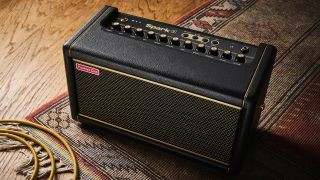 Positive Grid Spark 2 practice amplifier on a carpet.
Positive Grid Spark 2 practice amplifier on a carpet.
(Image credit: Future)
4. Positive Grid Spark 2
The smartest amp on the market just got even more powerful.
Our expert review:
Specifications
Watts: 40
Type: Modeling
Preamp tubes: N/A
Power amp tubes: N/A
Speakers: 2×4” custom designed speakers
Reasons to buy
- Impressive practice features
- AI Tone generation tool
- Awesome array of guitar tones
- Finally has a looper
Reasons to avoid
- Not designed for gigging
At a Glance
✅ Buy if you want great tones and practice tools: The Spark 2’s companion app delivers fantastic sounds and incredibly useful practice tools, making it a supremely good amplifier for electric guitar practice, combining tone and learning in one package.
❌ Avoid if you want to gig: Like the LT25, the Spark 2 lacks the power for live performance with louder instruments, so look elsewhere for a gigging amplifier if you need a good amplifier for electric guitar for stage use.
The original Positive Grid Spark revolutionized the practice amplifier market and has become the preferred choice for guitarists worldwide. The Spark 2 builds upon this success, incorporating a highly requested looper, enhanced sound quality, and upgraded AI-powered practice tools. For guitarists seeking a good amplifier for electric guitar specifically for practice, the Spark 2 is loaded with features that are both inspiring and beneficial for skill development.
The sound quality of the Spark 2 is remarkably impressive for its size, delivering substantial tones that defy its compact dimensions. The speakers are now angled slightly outward, which significantly enhances the breadth of the sound, particularly when using stereo effects like reverb and delay, creating a more immersive and enjoyable practice experience. The realism of the modeled sounds is also a major highlight, offering a wide range of inspiring and authentic tones, making it a truly good amplifier for electric guitar to explore different sonic landscapes.
Positive Grid has finally integrated a looper function, accessible via a smartphone app or the optional Spark Control X foot controller. The looper is surprisingly intuitive and effective, especially in groove looper mode when used with the phone app, allowing for rhythmic looping that enhances practice sessions.
The inclusion of an AI tone generator, accessible through the Spark App, enables users to create custom tones based on text prompts, similar to AI image generation. The accuracy of the generated tones is heavily dependent on the quality of the text prompts, but with well-chosen phrases, the system can produce remarkably accurate and inspiring sounds, adding a unique and innovative dimension to this good amplifier for electric guitar.
Read our full Positive Grid Spark 2 review
Best under $500
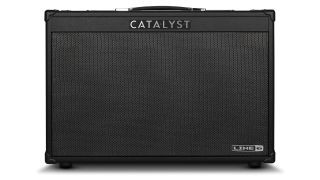 Line 6 Catalyst 200 guitar amplifier in a studio setting.
Line 6 Catalyst 200 guitar amplifier in a studio setting.
(Image credit: Line 6)
5. Line 6 Catalyst 200
Our pick for the good amplifier for electric guitar below the $500 price point.
Our expert review:
Specifications
Watts: 200W
Type: Modeling
Preamp tubes: N/A
Power amp tubes: N/A
Speakers: 2 x 12″ Custom Design
Reasons to buy
- Superb amp sounds
- High-quality effects
- Loud enough for gigging
Reasons to avoid
- Effects aren’t the most flexible
At a Glance
✅ Buy if you want a great value gigging amp: This 2×12″ amplifier provides significant power and clarity, making it a good amplifier for electric guitar for gigging musicians seeking value and performance.
❌ Avoid if you like lots of built-in effects: While there’s a fantastic selection of effects, you can only use two at a time, with one slot reserved for reverb, which may limit users who prefer complex effect chains in their good amplifier for electric guitar.
Positioned to compete with the popular Boss Katana series, the Line 6 Catalyst 200 is a potent modeling amplifier that delivers a wealth of features for under $500. For guitarists seeking a good amplifier for electric guitar that combines quality tones with gig-ready performance at an affordable price, the Catalyst 200 is an exceptional choice.
The Catalyst 200 is built around six distinct amp models, encompassing clean, boutique, chime, crunch, dynamic, and high-gain voicings. Based on classic amplifier designs from Fender, Marshall, Vox, and others, its dual 12-inch speakers produce pristine sounds with excellent clarity and significant power when the volume is cranked. This makes it a versatile and good amplifier for electric guitar suitable for various musical styles and performance settings.
Line 6 effects have long been respected for their quality, and the Catalyst 200 includes a superb selection from the HX series, featuring delays, choruses, reverbs, phasers, and many more. However, a limitation is that only two effects can be used simultaneously, and one of these must be reverb. For users who rely heavily on complex, multi-effect chains directly from their amplifier, this might be a constraint. However, for those who incorporate external pedals, this limitation becomes less significant. Overall, for a good amplifier for electric guitar that balances cost, quality, and gig-ready features, the Line 6 Catalyst 200 is a top recommendation.
Read our full Line 6 Catalyst 100 review
Best tube amp
 Fender '65 Deluxe Reverb amplifier in a classic setting.
Fender '65 Deluxe Reverb amplifier in a classic setting.
(Image credit: Future)
6. Fender ’65 Deluxe Reverb
An iconic amplifier that plays exceptionally well with pedals.
Our expert review:
Specifications
Watts: 22
Type: Tube
Preamp tubes: 4 x 12AX7, 2 X 12AT7
Power amp tubes: 2 x 6V6
Speakers: 1×12″ Jensen C12K
Reasons to buy
- Perfect for pedals
- Incredible valve tone
- Proper spring reverb
Reasons to avoid
- Doesn’t do high gain
At a Glance
✅ Buy if you want the ultimate tube amp: The Deluxe Reverb, a highly recorded amplifier, delivers luxurious tube tones, making it a perfect pedal platform and recording amplifier, and a truly good amplifier for electric guitar for classic tube sound.
❌ Avoid if you want high gain: If you prefer amplifier-derived gain, this amp, while sounding excellent, won’t reach the high-gain levels needed for metal genres compared to some other options in this guide.
The original Fender ‘65 Deluxe Reverb is one of the most celebrated amplifiers in history, having graced countless recordings over the decades. It is an iconic amplifier, and while vintage models are often prohibitively expensive, the reissue version captures the original magic while remaining accessible to most guitarists seeking a good amplifier for electric guitar with classic tube character.
As a pedal platform, this amplifier excels, requiring significant gain input before it reaches its own overdrive threshold. Its pristine clean tone is exceptionally versatile, working beautifully whether you’re pushing it with fuzz pedals or playing clean jazz lines. It’s also ideally suited for recording, as it achieves usable tones without needing to be cranked to extreme volumes like some larger amplifiers, making it a very good amplifier for electric guitar in studio environments.
It features two channels, each with two inputs, offering considerable flexibility in shaping your sound. The tube-driven reverb and tremolo are remarkably lush, allowing for a range of tones from subtle ambience to expansive, surf-inspired soundscapes. This combination of features solidifies the Fender ’65 Deluxe Reverb as one of the most versatile and good amplifier for electric guitar options available.
Read our full Fender ’65 Deluxe Reverb review
Best solid state amp
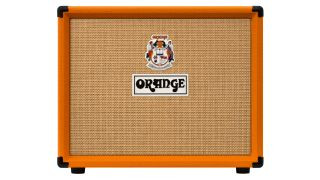 Orange Super Crush 100 guitar amplifier combo in orange tolex.
Orange Super Crush 100 guitar amplifier combo in orange tolex.
(Image credit: Orange)
7. Orange Super Crush 100 Combo
A super solid-state combo that’s excellent value for money.
Our expert review:
Specifications
Watts: 100W
Type: Solid state
Preamp tubes: N/A
Power amp tubes: N/A
Speakers: 1 x 12″ G12-K150
Reasons to buy
- Sounds like a tube amp
- Bags of headroom
- Huge range of tones
Reasons to avoid
- Obscure control labels
At a Glance
✅ Buy if you want great tone without the hassle: The Crush 100 sounds remarkably like the tube-equipped Rockerverb it’s based on, delivering some of the best non-tube guitar tones we’ve encountered, making it a good amplifier for electric guitar seeking tube-like sound without tube amp maintenance.
❌ Avoid if you like built-in effects: It lacks onboard effects, requiring a pedalboard for delays, chorus, and reverbs, so it may not be the best good amplifier for electric guitar if you prefer all-in-one solutions.
For guitarists seeking the rich tone of a tube amplifier but are constrained by budget, the Orange Super Crush 100 comes remarkably close without the high cost of tubes. It employs a JFET preamp design paired with the same power amp found in the popular Orange Pedal Baby, effectively recreating authentic tube amplifier tones. If you’re looking for a good amplifier for electric guitar that offers tube-like warmth and responsiveness in a solid-state package, the Super Crush 100 is a strong contender.
With two channels at your disposal, it covers a wide sonic spectrum from articulate clean tones to heavy metal distortion, and it offers substantial headroom for pushing the amplifier with your favorite pedals. The tone is strongly reminiscent of the classic Orange Rockerverb amplifiers, yet it maintains versatility thanks to its effective three-band EQ, making it a very good amplifier for electric guitar across many genres.
One potentially confusing aspect for new users is the use of picture icons instead of traditional text labels on the controls. However, a quick glance at the manual or a simple online search resolves this minor issue. The combination of channel and master volume controls makes this amplifier highly adaptable for diverse applications, and it stands out as one of the best solid-state amplifiers we have ever played, truly a good amplifier for electric guitar within the solid-state category.
Read our full Orange Super Crush 100 review
Best combo amp
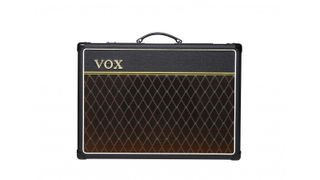 Vox AC15 C1 guitar amplifier in a vintage style setting.
Vox AC15 C1 guitar amplifier in a vintage style setting.
(Image credit: Vox)
8. Vox AC15 C1
The good amplifier for electric guitar for a vintage vibe with class to spare.
Our expert review:
Specifications
Watts: 15
Type: Tube
Preamp tubes: 12AX7
Power amp tubes: EL84
Speakers: 12” Celestion G12M Greenback
Reasons to buy
- Nails that iconic Vox tone
- You’ll love the tremolo
- Excellent portability
Reasons to avoid
- Not one for the high gain fans
At a Glance
✅ Buy if you want vintage guitar tones: This Vox delivers the classic ‘chime’ amp tone, perfect for those who appreciate vintage tube amplifier sounds. The onboard tremolo is also a fantastic feature in this good amplifier for electric guitar.
❌ Avoid if you want high gain: While it can achieve overdrive relatively easily, it won’t reach high-gain metal territory, so if you need extreme gain from your good amplifier for electric guitar, this might not be ideal.
Launched over 60 years ago, the Vox AC15 is the veteran in this guide to the best guitar amplifiers. Yet, its iconic grille still captivates, promising one of the most recognizable guitar tones in music history, utilized by artists from the Beatles to Brian May. For guitarists seeking a good amplifier for electric guitar with timeless vintage tone, the AC15 remains a benchmark.
This amplifier offers a broad tonal range, from its signature sparkling clean sound to a mid-heavy, compressed overdrive. The high frequencies are complex yet articulate, while the low-end response is punchy and dynamic, performing equally well with both single-coil and humbucker-equipped guitars. This tonal versatility makes it a highly good amplifier for electric guitar across genres.
The onboard tremolo is particularly appealing, with speed and depth controls allowing for settings ranging from a slow, gentle warble to a more pronounced, gated effect. It also features a spring reverb with a single level control, perfect for adding surf-guitar ambience to your sound. As far as combo amplifiers go, the Vox AC15 is hard to surpass if you’re drawn to classic tones, truly a good amplifier for electric guitar for vintage sound enthusiasts.
Best for metal
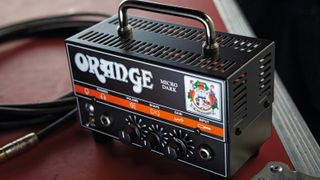 Orange Micro Dark guitar amplifier head on a speaker cabinet.
Orange Micro Dark guitar amplifier head on a speaker cabinet.
(Image credit: Future)
9. Orange Micro Dark
A micro amp with a massive sound.
Our expert review:
Specifications
Watts: 20
Type: Hybrid
Preamp tubes: 12AX7
Power amp tubes: N/A
Speakers: N/A
Reasons to buy
- Excellent tone options
- Compact size for gigging
- Speaker emulation out
Reasons to avoid
- Not a full tube amp
At a Glance
✅ Buy if you want a compact metal amp: The Micro Dark packs significant metal punch in a small package, making it a good amplifier for electric guitar for metal players needing portability.
❌ Avoid if you prefer tube amps: As a hybrid amp with tubes only in the preamp stage, tube purists might not fully appreciate it, but for metal tones in a small format, it is a good amplifier for electric guitar.
The Orange Micro Dark is one of Orange’s most popular offerings and stands out as one of the best metal amplifiers in a compact form factor. Combining excellent tone, portability, and useful connectivity options, it offers exceptional value and deserves a place in any metal guitarist’s rig. For those seeking a good amplifier for electric guitar specifically for metal genres, the Micro Dark delivers impressive performance in a small size.
Orange’s ‘micro’ designation is accurate – this amp is remarkably small and lightweight, comparable to some practice amplifiers. Despite its size, it can produce a volume level that will have audiences quickly reaching for earplugs, especially when paired with a suitable cabinet. It delivers the classic Orange midrange character in abundance, offering both a pleasing clean channel and gain that ranges from classic rock to djent styles, making it a versatile and surprisingly good amplifier for electric guitar across gain levels.
In addition to a traditional speaker output, it also includes a speaker-emulated output for direct injection into a mixing desk or for home recording setups. This output doubles as a headphone jack, enabling silent practice, completing the comprehensive feature set of this brilliant and good amplifier for electric guitar.
Read our full Orange Micro Dark review
Best for jazz
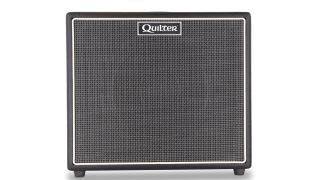 Quilter Aviator Mach 3 guitar amplifier combo in a studio setting.
Quilter Aviator Mach 3 guitar amplifier combo in a studio setting.
(Image credit: Quilter)
10. Quilter Aviator Mach 3 Combo
A lightweight yet powerful amp that’s great for jazz tones.
Our expert review:
Specifications
Watts: 200W
Type: Solid state
Preamp tubes: N/A
Power amp tubes: N/A
Speakers: 1 x 12″ Celestion Copperback
Reasons to buy
- Incredible clean tones
- Nice and lightweight
- Plenty of power for gigging
Reasons to avoid
- Dirt sounds aren’t the best
At a Glance
✅ Buy if you want loud clean tones with lots of headroom: The Aviator Mach 3 provides 200W of power, delivering brilliant clean tones with extensive headroom, making it a good amplifier for electric guitar for jazz and styles needing a pristine clean foundation.
❌ Avoid if you need high gain: The distortion setting is not its strength, so if you require high-gain tones directly from your amplifier, this may not be the ideal good amplifier for electric guitar.
For jazz guitarists, a superb clean amplifier is essential. While traditional choices might include Fender tube amps or Roland Jazz Chorus models, the Quilter Aviator Mach 3 offers a compelling alternative. Its exceptional clean power combined with its lightweight design makes it an outstanding choice for jazz players, whether gigging or practicing, and a truly good amplifier for electric guitar focused on clean jazz tones.
The volume and clean headroom of the Mach 3 are exceptionally impressive. It easily keeps pace with loud drummers and is well-suited for big band settings. The six amp voices provide significant versatility for blending in or standing out, depending on the musical context, and the Celestion speaker delivers a beautifully balanced guitar tone. For jazz musicians, this makes it a highly good amplifier for electric guitar.
It features two identical channels, allowing you to set up slightly varied amp voices or entirely different clean and dirty tones, switchable via an optional footswitch. Dual inputs enable running two instruments through the same amplifier, which can be useful in certain situations. It also includes quality reverb and tremolo effects. The only slight drawback is its distortion, which is not its strongest feature, suggesting that an overdrive pedal might be preferred for driven tones. However, for clean jazz tones and lightweight portability, the Quilter Aviator Mach 3 is a superb and good amplifier for electric guitar.
Best pedal amp
 Strymon Iridium pedal guitar amplifier on a pedalboard.
Strymon Iridium pedal guitar amplifier on a pedalboard.
(Image credit: Future)
11. Strymon Iridium
A great sounding and easy-to-use pedal amplifier.
Our expert review:
Specifications
Watts: N/A
Type: Digital
Preamp tubes: N/A
Power amp tubes: N/A
Speakers: N/A
Reasons to buy
- Pedalboard-friendly size
- Trio of classic amp tones
- Load your own IRs
Reasons to avoid
- Needs a 500mA power source
At a Glance
✅ Buy if you want a pedalboard-friendly amp: Strymon’s popular pedal amplifier is ideal for pedalboards due to its compact size and straightforward controls, eliminating the need for complex apps or software, and making it a very good amplifier for electric guitar in a pedal format.
❌ Avoid if you don’t have good monitoring: For live use, good FRFR speakers or excellent monitoring are necessary, so it might not be suitable if venues lack adequate PA systems, requiring careful consideration as a good amplifier for electric guitar in live contexts.
In today’s music scene, transporting traditional guitar amplifiers to gigs is no longer essential. The Strymon Iridium, while not new, remains one of the best pedal amplifiers available, known for its excellent sound quality and ease of operation. For guitarists seeking a good amplifier for electric guitar that is incredibly portable and pedalboard-friendly, the Iridium is a top choice.
The Iridium provides three classic amp sounds, inspired by Fender, Vox, and Marshall amplifiers, easily adjustable via physical knobs on the pedal’s face. While an app is available for deeper tweaking, users who prefer traditional amplifier controls will appreciate the tactile feel of the physical knobs. This focus on usability makes it a very good amplifier for electric guitar for players who value hands-on control.
It comes preloaded with nine cabinet impulse responses, ranging from 1×12 to Mesa 4×12 configurations, offering significant flexibility in tone shaping. Users can also load custom IRs or bypass the cabinet modeling altogether. A built-in room reverb adds ambience for an amp-in-a-room feel, and it includes comprehensive connectivity to suit various setups. As a pedal-based solution, it’s a remarkably good amplifier for electric guitar offering tonal versatility and convenience.
Read our full Strymon Iridium review
Best amp modeler
 Neural DSP Quad Cortex amp modeler on a desk.
Neural DSP Quad Cortex amp modeler on a desk.
(Image credit: Future)
12. Neural DSP Quad Cortex
One of the most powerful amp and effects modelers ever made.
Our expert review:
Specifications
Watts: N/A
Type: Digital
Preamp tubes: N/A
Power amp tubes: N/A
Speakers: N/A
Reasons to buy
- Endless array of tones
- Big and clear screen
- Portable yet tough
Reasons to avoid
- May be too complex for some
At a Glance
✅ Buy if you want to get rid of your amp entirely: The Neural DSP Quad Cortex replaces your entire rig, from amplifier to cabinet to pedalboard, offering more than just multi-effects, it’s a complete and very good amplifier for electric guitar replacement in a modeler.
❌ Avoid if you don’t like tweaking: Maximizing its potential requires time for setup and tone tweaking; if you’re not tech-savvy or dislike software interfaces, this might not be the best good amplifier for electric guitar for you.
The Neural DSP Quad Cortex is among the best amp modelers available, offering capabilities that extend beyond just amp modeling. It can capture amp and pedal tones, function as an audio interface, and serve as a comprehensive replacement for a traditional amplifier setup, representing a new paradigm in how guitarists manage their rigs. For those seeking a good amplifier for electric guitar that offers unparalleled sonic flexibility and advanced features, the Quad Cortex is a leading option.
The sheer variety of available sounds is astounding. It includes models of virtually any amplifier imaginable, each captured with pristine realism. Furthermore, it allows users to model their existing equipment, ensuring your signature sound remains consistent regardless of the setup. This capability makes it a powerfully good amplifier for electric guitar for players who value sonic consistency and versatility.
The large LCD touchscreen enhances usability, making patch changes and adjustments straightforward. The footswitches, which also function as rotary controls, are an innovative design, subsequently adopted by other manufacturers. Connectivity is extensive, accommodating various setups, whether you’re integrating it with a hybrid amp rig, using it for recording, or replacing your live rig entirely. In summary, the Neural DSP Quad Cortex is a highly advanced and versatile good amplifier for electric guitar for the modern guitarist.
Read our full Neural DSP Quad Cortex review
Spec comparison
Swipe to scroll horizontally
| Amp | Type | Watts | Speaker |
|---|---|---|---|
| Boss Katana 50 Gen 3 | Modeling | 50 | 1×12″ |
| Fender Tone Master Twin Reverb | Modeling | 200 | 2×12″ |
| Fender Mustang LT25 | Modeling | 25 | 1×8″ |
| Positive Grid Spark 2 | Modeling | 50 | 2×4″ |
| Line 6 Catalyst 200 | Modeling | 200 | 2×12″ |
| Fender ’65 Deluxe Reverb | Tube | 22 | 1×12″ |
| Orange Super Crush 100 | Solid State | 100 | 1×12″ |
| Vox AC15 C1 | Tube | 15 | 1×12″ |
| Orange Micro Dark | Hybrid head | 20 | N/A |
| Quilter Aviator Mach 3 | Solid State | 200 | 1×12″ |
| Strymon Iridium | Modeling | N/A | N/A |
| Neural DSP Quad Cortex | Modeling | N/A | N/A |
Also consider
The guitar amplifiers listed above represent our top recommendations for your consideration. However, given the diverse needs of guitarists, if you haven’t found your ideal match yet, here are some additional highly-rated options for a good amplifier for electric guitar.
PRS MT15 Mark Tremonti Tube head | 15W | JJ EC83S, 6L6
The MT 15 follows the lunchbox amp design, offering two channels and switchable output power, making it suitable for practice, recording, and smaller performances. It’s clearly aimed at higher gain enthusiasts, with 6L6 power amp tubes providing ample saturation. ★★★★½
Read more: PRS MT15 Mark Tremonti review
 Marshall DSL40CR Tube combo | 40W | 4 x ECC83, 2 x EL34 | 1×12” Celestion V-Type½
Marshall DSL40CR Tube combo | 40W | 4 x ECC83, 2 x EL34 | 1×12” Celestion V-Type½
Marshall DSL40CR Tube combo | 40W | 4 x ECC83, 2 x EL34 | 1×12” Celestion V-Type
The Marshall DSL40CR aims to deliver the classic Marshall 4×12 sound in a more practical format. Tonally versatile and portable, the DSL40CR is an all-tube amplifier offering excellent value for gigging guitarists. ★★★★½
Read more: Marshall DSL40CR review
Blackstar HT Club 40Tube combo | 40W | ECC83, EL34 | 1x 12” Celestion
The Blackstar HT Club 40 has been a standard for mid-priced tube amps for some time, featuring foot-switchable voices that offer American or British tonal characteristics, effectively providing four amplifier tones in one. ★★★★½
Read more: Blackstar HT Club 40 review
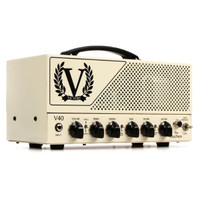 Victory V40 The DuchessTube head | 40W | 12AX7, EL34
Victory V40 The DuchessTube head | 40W | 12AX7, EL34
Victory V40 The DuchessTube head | 40W | 12AX7, EL34
Despite its compact size, the Victory V40 can produce significant volume. It’s a 40-watt, single-channel tube head capable of both US and UK style tones, and its substantial clean headroom makes it an exceptional pedal platform. ★★★★★
Read more: Victory V40 The Duchess review
Buying advice
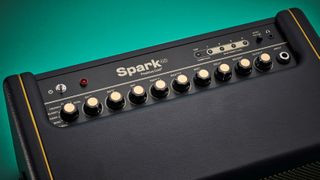 Positive Grid Spark amplifier image with a hand adjusting knobs.
Positive Grid Spark amplifier image with a hand adjusting knobs.
(Image credit: Future)Guitar amplification fundamentally relies on three core components: the preamp, power amp, and speaker. The preamp shapes the initial sound, the power amp amplifies it to drive the speaker, and the speaker projects the resulting tone. Understanding these elements is key to selecting a good amplifier for electric guitar.
Should I buy a tube, solid state or digital amp?
A primary consideration is whether to choose a tube, solid-state, or digital (modeling) amplifier when looking for a good amplifier for electric guitar. Tube amplifiers offer a unique dynamic response and harmonic richness, stemming from the physical interaction within vacuum tubes. This results in a warm, dynamic tone that many players still prefer, especially when pushing the power amp section at stage volumes. For players prioritizing organic feel and classic tones, a tube amp can be a good amplifier for electric guitar.
Modeling amplifiers excel in versatility and immediate access to a wide range of tones. Modern modeling technology accurately recreates hundreds of amplifier models across genres, providing a vast sonic palette. They also typically include extensive options for cabinet and speaker simulations, along with a variety of built-in effects. This makes them excellent for musicians in cover bands needing diverse sounds, or for beginners exploring different tonal styles. For versatility and convenience, a modeling amp can be a good amplifier for electric guitar.
The distinction between solid-state and modeling amps has become less defined, but generally, solid-state amps do not emulate different amplifier models like digital amps. While sometimes overlooked by tone purists, modern solid-state technology, particularly Class D power amps, offers efficiency and compact size. They often lean towards cleaner tones, making them excellent pedal platforms. However, their overdriven and distorted tones may not always match the depth and character of high-end modelers or tube amps. For clean tones and pedalboard integration, a solid-state amp can be a good amplifier for electric guitar.
Do I want a combo or a head?
Combo amplifiers integrate the preamp, power amp, and speakers into one unit, while heads require separate speaker cabinets. Heads offer the flexibility to use different speaker configurations, but in modern contexts where venues often have PA systems and noise restrictions are common, the need for extreme volume is less critical. Combo amps are advantageous for portability and ensuring consistent sound quality across different venues. If portability and consistent sound are key, a combo amp might be the good amplifier for electric guitar choice.
Combo amps are ideal for musicians who want to transport their carefully crafted sound easily. Knowing your sound will be consistently delivered is a significant advantage. However, combo amps can be heavy, which might make smaller, more portable head and cabinet setups appealing, especially for navigating tight venue spaces.
Is guitar amp wattage important?
Yes, wattage is a significant factor. Generally, higher wattage means greater volume. However, tube amps are perceived as louder than solid-state or modeling amps of the same wattage due to their harmonic characteristics. For example, a 10-15 watt tube amp can sound as loud as a 50-watt digital amp. Consider this difference when choosing wattage, especially if volume is a primary concern. Matching wattage to your typical playing environment is crucial in selecting a good amplifier for electric guitar.
Therefore, carefully consider your volume needs before opting for a high-wattage tube amplifier and a large speaker cabinet. For home practice, lower wattage amps are generally sufficient, while gigging musicians might need higher wattage for stage volume and headroom.
How much gain does my guitar amp need?
Finally, consider your gain requirements. If you use pedals for overdrive and distortion, a clean amplifier platform might be ideal. However, for players, especially in heavier genres, a high-gain amplifier can provide a richer, more dimensional distortion than many pedals. Also, consider the number of channels an amplifier offers, particularly if you need to switch between clean and distorted tones frequently. Matching gain capabilities to your playing style is vital in finding a good amplifier for electric guitar.
How we test the best guitar amps
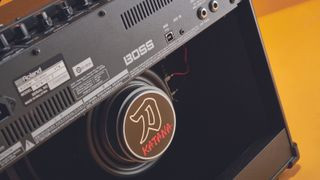 Close up of the speaker on a Boss Katana 50 modeling amplifier.
Close up of the speaker on a Boss Katana 50 modeling amplifier.
(Image credit: Future)Our testing process for guitar amplifiers is designed to thoroughly evaluate each unit’s performance across various criteria. Given the diverse types of guitar amplifiers available, our testing approach is adapted based on the amplifier’s intended use. For amplifiers designed for stage or rehearsal use, volume and projection are critical factors, while for home practice amps, these are less emphasized. However, build quality remains a consistent priority across all amplifier types when determining what constitutes a good amplifier for electric guitar.
Regardless of intended use, build quality is paramount. We assess whether each amplifier is well-constructed and robust. Guitar amplifiers should feel durable and capable of withstanding regular use. Controls should operate smoothly with appropriate resistance, indicating quality components and assembly. These aspects of build quality are key indicators of a good amplifier for electric guitar‘s longevity and reliability.
To evaluate tonal performance, we begin with all settings at neutral to hear the amplifier’s inherent sound. This provides a baseline for assessing its sonic character. We then adjust the controls to shape the sound, paying close attention to the EQ controls and their effectiveness in altering the tone. We test the amplifier across its gain spectrum, from maximum saturation to the cleanest possible settings. This comprehensive tonal testing is crucial for determining if an amplifier is a good amplifier for electric guitar across different genres and playing styles.
If an amplifier includes additional features like effects or attenuators, we thoroughly test each function to ensure they perform as expected and enhance the amplifier’s versatility. Our goal is to rigorously examine every aspect of the amplifier to provide a comprehensive and reliable assessment of its overall quality and suitability as a good amplifier for electric guitar.
Read more about our rating system, how we choose the gear we feature, and exactly how we test each product.

